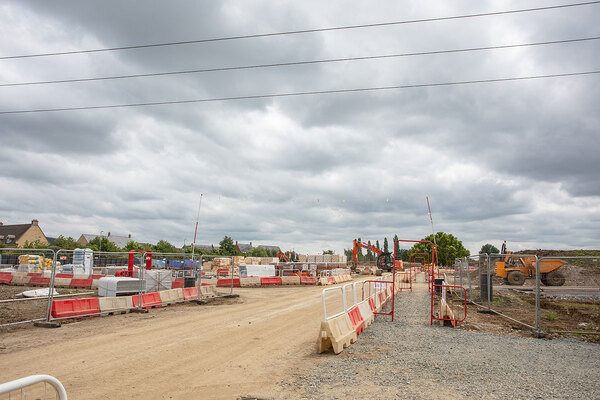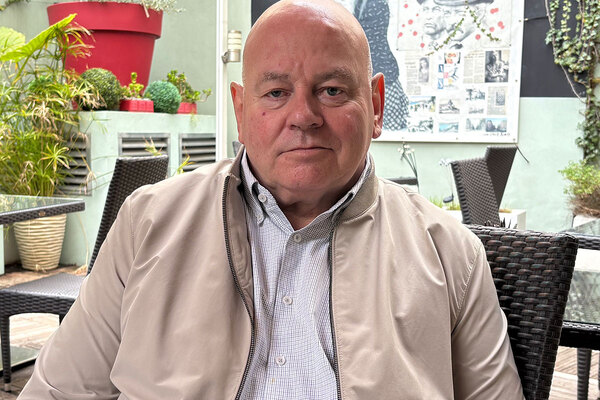Divided ambitions
When Eric Pickles axed the regional planning system, one Hertfordshire council seized the opportunity to scupper a neighbouring authority’s development plans. Simon Brandon kicks off our south east special by examining the consequences.

Privet hedges and punch-ups: stories about planning disputes between neighbours can be entertaining, but for those involved, they’re stressful, often extremely bitter experiences.
The arbiter is usually the local authority - but sometimes neighbouring councils are the ones quarrelling over the fence.
In December, the High Court settled a dispute between North Hertfordshire Council and its neighbour, Stevenage Council. As part of its core strategy, drawn up in accordance with the east of England regional plan, Stevenage had planned for the development of around 16,000 new homes by 2026.
Of those, more than half - 9,600 - were to be built across Stevenage’s local authority boundary in neighbouring North Hertfordshire, and until June 2010, things were going well. Possible sites in North Hertfordshire had been identified, and the two councils were working together on a Stevenage and North Hertfordshire Area Action Plan, or SNAP.
But North Hertfordshire was not, as it turned out, such a willing partner. On 27 May 2010, shortly after the general election, newly installed communities and local government secretary Eric Pickles wrote to every local authority promising an imminent end to the regional planning system.
‘I expect local planning authorities and the Planning Inspectorate [for England and Wales, an executive agency of the Communities and Local Government department] to have regard to this letter as a material planning consideration in any decisions they are currently taking,’ Mr Pickles wrote.
Legal obligation
Two weeks later North Hertfordshire did just that, and dropped its commitment to Stevenage’s planned expansion. The previous government’s planning system, which was based on regional targets, meant North Hertfordshire was legally obliged to go along with its neighbour’s plans to expand. In delaying submission of its core strategy - a document that every local planning authority has to prepare, which outlines its development objectives - until that system was thrown out altogether, it was freed from that commitment.
Instead of being bound to the east of England regional plan, which was published in 2008 and included targets for 500,000 new homes to be built by 2031, North Hertfordshire could concentrate purely on its own housing needs.
‘We didn’t see the need for building on all the land north of Stevenage,’ explains Tom Brindley, portfolio holder for planning at North Hertfordshire, which has 2,500 households on its housing waiting list. ‘We are here to fulfil the needs of North Hertfordshire… and North Hertfordshire certainly doesn’t need [the new houses].’
Whether the region as a whole needs them is a separate issue. The housing targets in the east of England were based on projected economic and population growth, which was estimated to see the number of people in the region increase from 5.6 million to 7 million by 2031.
According to John Gardner, Mr Brindley’s opposite number at Stevenage Council, which has a 5,100-strong housing waiting list, his council’s plans were as much about stimulating the local economy and securing future job creation as they were about meeting current housing need.
Frankie Trudgill, project manager at the Stevenage Haven, a charity which provides support and accommodation for 36 single homeless people at any one time, however, is certain that demand for new homes alone justifies the building of the planned 16,000 properties. She describes the housing situation in the town is ‘dire’.
‘I can prove that by the fact that we have people living in the hostel that we cannot move on because there are no homes available,’ she says. ‘If the homes were built across the border, it would ease the pressure on accommodation in town. I know of a family of five living in a two-bedroom flat - families like that could move to a more suitable affordable home, leaving a flat for a single homeless person.’
Yet it looks as though Stevenage Council’s ambitions will have to be drastically scaled back.
‘Whatever total we come up with [now], it [the 16,000 homes figure] will probably cut in half, although we haven’t finished that exercise,’
Mr Gardner says, adding that the original aim was for 30 to 40 per cent (around 5,600) of those homes to be made affordable.
In December, the High Court found that Stevenage’s core strategy was unsound because it could no longer depend on the co-operation of North Hertfordshire.
In a statement to parliament in July 2010, Mr Pickles decried the ‘previous government’s failed Soviet tractor-style, top-down planning targets’. He promised to replace regional plans with ‘powerful new incentives for local people so they support the construction of new homes in the right places’.
Since then, the government has passed the Localism Act and has published a draft national planning policy framework based on it - both aim to devolve planning decisions to a local level.
Inside Housing’s Get On Our Land campaign has the straightforward aim of freeing up land on which to build homes. Councils still have to identify and meet their own housing needs under the coalition government’s planning system - but in the absence of regional planning strategies, is there a limit to the extent towns like Stevenage can expand to meet need? More broadly, what might this mean for house building numbers in England?
Limited growth options
Stevenage is home to around 81,000 people. As a new town built after Word War II, it was designed with emphasis on green spaces and the retention of natural features such as hedgerows, trees and ponds. Stevenage shares another pertinent characteristic with its fellow new towns, according to Ian Tant, senior partner at planning consultancy Barton Willmore.
‘Most new towns were designated within fairly restrictive boundaries,’ he explains. Once towns like Stevenage had evolved into free-standing local authorities, he adds, this meant their options for growth were limited, especially if the green spaces intrinsic to their character were to endure.
The town has two local authority neighbours, both district councils: North Hertfordshire and East Herts. Each is a relatively large, mostly rural area containing a few market towns and plenty of green belt. To look at North Hertfordshire in isolation - as its planners are now free to do - it is easy to see why the local authority withdrew from SNAP. Discounting Stevenage’s proximity, the plans would have stuck thousands of homes in a large rural chunk - 500 hectares - of the district.
North Hertfordshire’s Mr Brindley argues that the housing was not needed in the first place. Instead, he describes Stevenage’s plans as aspirational. ‘It says: “We’d like to be bigger, therefore we’ll build more housing - but we don’t have the land, so we’ll take someone else’s.” That’s not the way we believe it should be done,’ he says. ‘The houses were never needed. The east of England plan came up with massive growth figures [based on the projections for economic growth], and that is what we really question.’
Stevenage’s Mr Gardner does not agree with Mr Brindley’s choice of words. ‘The figures in the east of England plan were entirely compatible with figures we considered were necessary,’ he says. ‘The determining factor in housing numbers was allied to economic growth and job creation.’
It’s not just North Hertfordshire that objected to the homes. Jack Rigg is a spokesperson for Graveley Against SNAP Proposals, an action group formed by residents of the village of Graveley, which sits just to the north of Stevenage.
‘We didn’t wish to be part of Stevenage,’ he says. ‘We didn’t want our village to be engulfed.’
The scrapping of regional plans has been ‘good news’, Mr Rigg adds: ‘It allows North Hertfordshire and other local authorities to plan their housing according to their needs and in discussion with their electorates, rather than having central government impose housing targets on areas where perhaps discussion hadn’t taken place.’
The Graveley protestors wish to keep some green space between themselves and Stevenage, and the shift towards localism appears to mean they are now more likely to do so. From a local democracy perspective, Mr Rigg insists, the scrapping of regional plans must be a good thing.
Strategic planning
This step down from regional plans to local decision making looks as though it is going to make strategic planning - taking into account both economic growth and housing demand - difficult to carry out, especially if one area’s demands cross a boundary, and the need for new homes do not fit in with the housing needs of the neighbouring authority.
The new homes bonus, introduced in April last year, aims to incentivise councils in England to build properties. For each new home built, and each long-term disused property brought back into use, the government will pay councils the equivalent of the council tax for each new home, with a bonus for affordable housing, for the next six years.
This unringfenced grant - the government paid out around £200 million in the first year - has been welcomed by some local authorities struggling with budget cuts (Inside Housing, 27 January 2012). However, it wasn’t enough of a sweetener for North Hertfordshire to continue to support Stevenage’s plans - and membership body the Home Builders Federation questions how much of an incentive it will be in similar circumstances across the country.
‘We’re urging the government to make sure that the new homes bonus is increasing house building, and if it isn’t to move from a carrot to a stick approach,’ says a spokesperson for the federation.
Duty of co-operation
When it comes to cross-boundary issues there is a stick, of sorts, embedded within the incoming planning system. The Localism Act places a duty of co-operation on councils, which will need to demonstrate in their core strategies that they have been in consultation with neighbouring authorities.
But it remains to be seen what this will mean in practice. If, as Mr Tant points out, another council decides it needs to encroach onto your area, there is nothing in the NPPF that says your plan is unsound because you do not agree.
‘That is where the duty to co-operate runs into difficulties,’ he says. ‘We are all in our profession wondering where that will get you … It is by no means certain that it will increase the housing provision for those areas that cannot meet their [own] needs [themselves]. The jury is out.’
The jury will be deliberating for a while yet. The regional plans are not quite in the legal dustbin yet, and nor has the NPPF been implemented (the government hopes to publish the final version on 31 March).
‘It’s a bugger’s muddle, frankly,’ says one senior planning consultant. ‘At the moment we are operating in a policy vacuum.
‘We are looking at a period of legal cases and planning appeal cases for the next couple of years until we get some consistency in how the legislation is going to be interpreted. Inevitably it will slow up house building,’ he adds.
‘With that power comes responsibility,’ explains Mr Tant - but whether a concept as nebulous as a duty to co-operate can compel councils to exercise that responsibility is yet to be established.
‘The duty to co-operate doesn’t say on its own what the objective of the co-operation involves,’ observes Stevenage Council’s Mr Gardner. ‘Do you co-operate with your neighbour not to build houses or to build houses,’ he asks.
On the other side of the privet hedge, his neighbour, North Hertforshire’s Mr Brindley, has a straightforward answer. ‘We are still obliged to co-operate with Stevenage,’ he concludes. ‘We are not obliged to agree with them.’
The ruling explained
In December, the High Court threw out a challenge brought by Stevenage Council against an independent planning inspector’s report on the council’s plans for growth across its border with North Hertfordshire Council.
The inspector had ruled Stevenage’s plan unsound, because it depended on co-operation from a neighbouring council that was openly hostile to the plans. Stevenage claimed that the inspector - and North Hertfordshire - was wrong to take into account the government’s decision to revoke the regional plans as they were still, technically, legally binding.
In his judgment, Mr Justice Ouseley ruled that North Hertfordshire’s core strategy only had to comply with the east of England plan if it was submitted for examination by inspectors before the regional planning system was scrapped - something North Hertfordshire had no intention to do. More practically, he pointed out the difficulties in working with a partner who had been openly against those plans from the start.
While admitting that this planning policy interregnum had created ‘very unusual circumstances’, the judge found that ‘there is something of an air of unreality about the submissions of Stevenage Council’.
He went on: ‘The statutory requirement to test a plan for its soundness involves, obviously, consideration of its practical implementation. The Stevenage core strategy is critically dependent for its practical implementation on a local authority, which is opposed to that strategy and intends not to co-operate in its achievement.’
In a statement, Stevenage says it has ‘reserved its position and will be taking further legal advice before making any decision early in 2012’.








